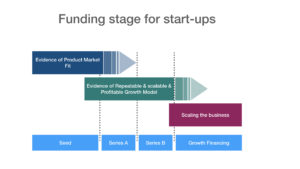A roadmap for scaling your start-up
A study of the survival rate of newly created companies by the Enterprise Research Centre in 2013, in the UK, found that only 54% manage to live past three-year. Furthermore, only 2% manage to scale over the same time period to reach one million £ turnover. A sobering statistic, illustrating once more the risks and difficulties faced by founders who try to scale their ventures.
Scaling is a complex process for any start-up. It that depends on a multitude of factors, and has been called a “black art” by venture capitalist Ben Horowitz. In this post, we will look at three key phases that start-up go through as they build their business: achieving product market fit, building a repeatable and scalable sales model, and finally professionalising the team and organisational structure. These concepts have been very well explored by numerous authors like Steve Blank and David Skok, who have written very insightfully about them.

Achieving product market fit
At the start of every start-up journey, the focus of the founding team is predominantly to get the product right. Founders usually thrive on creating a product around a new core technology and they are passionate about it. To commercialise these innovations, they need to validate their model with a first cohort of customers. These are often innovators and early adopters themselves who influence product development through their feedback and the dialogue they establish with the team.
A measure of success in this phase is how much customers are willing to pay for the product, and how engaged they are. They are also typically satisfied that the new solution has delivered on expectations, and as a result they are willing to promote and recommend it to others.
The size of this first customer group can vary depending on the average order size and the length of the sales cycle, but I believe a good sample size would be around 20 to 40 customers. I have seen investors seek that number to be fully satisfied.
This phase is characterised by an iterative approach to perfect the product and adjust the customer target group. At the end of it, it is essential that the founding team reaches a point where the product is stable and churn is low. This is when it also becomes clear that the product is able to solve a specific pain point, and serves a clear use case without requiring repeated modifications for every new customer.
Finally, as they go through this process, founders will have to guide product development in such a away as to aim for a large addressable market. The size of this market will make it possible for the business to grow on the long term and influence the company valuation which in turn will attract investors.
A repeatable, scalable sales model
In this next phase, which is intimately linked to the first one, and often overlapping, the founding team completes its understanding of what a typical customer journey looks like and what a successful sales process entails. The goal here is to master the methods and processes of acquiring new customers, on-boarding them properly and ensuring they succeed in adopting the product.
The founding team will need to experiment with various routes to market and determine the most successful ways to reach different customers. They may have a low touch online strategy to attract and convert leads, or a mid-touch strategy leveraging inside sales, and finally a high touch strategy where they use a direct sales force to engage Enterprise customers, or act as evangelists for the new product.
Scalability of the business will also depend on the number and potential size of lead sources. A robust go-to-market strategy will rely on a number of different sources, and will involve constant benchmarking for effectiveness and cost of the various demand generation activities.
The important point about these strategies is that they should be predictable and repeatable. This requires the founding team to start documenting and formalising their knowledge so as to transfer it to new team members. This is especially true of the direct sales force, which will require an excellent quality training and induction program to get to a high level of productivity quickly.
Finally, when all these elements are in place, the founding team will also need to set up a good reporting system to track progress in the funnel and measure sales and profitability metrics.
Reorganising the team for scale
The third phase in preparing the team for scale, is transitioning the organisation from one designed for learning and discovery to a well-oiled machine engineered for execution. This is coupled with an evolution to a more mature level of organisation with more specialised hires and stronger internal processes to manage the growing number of individual contributors. This is often harder than it seems because of the way some founding teams resist these trends. They prefer to keep a centralised control of the organisation and try to preserve agility and speed of execution at the expense of structure and planning. However, by doing so, founders run the risk of becoming a bottle neck for decision making and information sharing, leading to underperformance and dissatisfaction amongst new hires.
The renewed team must be able to handle greater levels of complexity and face new challenges such as choosing new growth directions, entering new markets, developing new products and more generally sustaining the culture of innovation. The way it’s organised will also evolve from a small intimate group reporting to a founder CEO to a team with additional levels of hierarchy and new reporting lines. Intuitive actions will make room for more disciplined planning and long-term preparation. Regular goal setting will slowly become the norm. New systems of accountability will be set up to keep people engaged and aligned with their goals. Finally, the company culture which has been so essential to attracting and motivating new hires will need to be codified and documented in order to be preserved.

As a founding team starts building a new business, its attention shifts successively from creating the product, to selling to the first customers and then to building an organisation with the right people on-board. Companies that can steadily move through these stages and avoid the numerous pitfalls will be amongst the few that become established players.